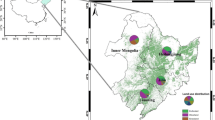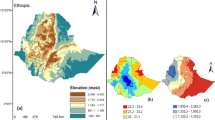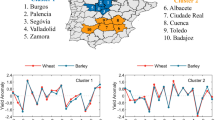Abstract
Using recent advances in statistical crop yield modelling and a unique dataset consisting of yield time series for Russian regions over the period from 1955 to 2012, the study investigates the potential impact of climate change (CC) on the productivity of the three most important grains. Holding current grain growing areas fixed, the aggregate productivity of the three grains is predicted to decrease by 6.7% in 2046–2065 and increase by 2.6% in 2081–2100 compared to 1971–2000 under the most optimistic representative emission concentration pathway (RCP). Based on the projections for the three other RCPs, the aggregate productivity of the three studied crops is assessed to decrease by 18.0, 7.9 and 26.0% in the medium term and by 31.2, 25.9 and 55.4% by the end of the century. Our results indicate that CC might have a positive effect on winter wheat, spring wheat and spring barley productivity in a number of regions in the Northern and Siberian parts of Russia. However, due to the highly damaging CC impact on grain production in the most productive regions located in the South of the country, the overall impact tends to be negative. Therefore, a shift of agricultural production to the Northern regions of the country could reduce the negative impact of CC on grain production only to a limited extent. More vigorous adaptation measures are required to maintain current grain production volumes in Russia under CC.



Similar content being viewed by others
Notes
Economic regions represent federal subjects, grouped according to certain common characteristics, such as geographic location, availability of natural resources and similar climate conditions, and level of development.
Oblast and krai are territorial units that can correspond to province, just as autonomous republic, but with a lower level of independence from the federal government. For simplicity, in the text, we use the term oblast for all three different types of federal subjects and refer to economic regions as regions.
For a graphical description of Russian territorial division, see Fig. S1 in Online Supplementary Material.
See Online Supplement Material for the descriptive statistics
Please see Online Supporting Material for a description of RCP scenarios used in this study.
Please see Online Supporting Material for a descriptive statistics for the baseline and projected periods for each of the pathways.
References
Alcamo J, Dronin N, Endejan M, Golubev G, Kirilenko A (2007) A new assessment of climate change impacts on food production shortfalls and water availability in Russia. Glob Environ Chang 17(3–4):429–444. https://doi.org/10.1016/j.gloenvcha.2006.12.006
Burke M, Emerick K. (2013) Adaptation to climate change: evidence from US agriculture (no. available at SSRN 2144928)
Chatzopoulos T, Lippert C (2015) Adaptation and climate change impacts: a structural Ricardian analysis of farm types in Germany, J Agr Econ, p. n/a–n/a
Conley TG (1999) GMM estimation with cross sectional dependence. J Econometrics 92(1):1–45
Deschênes O, Greenstone M (2007) The economic impacts of climate change: evidence from agricultural output and random fluctuations in weather. Am Econ Rev 97(1):354–385
Fisher AC, Hanemann WM, Roberts MJ (2012) The economic impacts of climate change: evidence from agricultural output and random fluctuations in weather: comment. Am Econ Rev 102(7):3749–3760
Hsiang SM (2010) Temperatures and cyclones strongly associated with economic production in the Caribbean and Central America. PNAS 107(35):15367–15372
IPCC (2013) Climate Change 2013: The Physical Science Basis. Contribution of Working Group I to the Fifth Assessment Report
IPCC (2014) Climate change 2014: impacts, adaptation and vulnerability—contributions of the Working Group II to the Fifth Assessment Report, doi: https://doi.org/10.1016/j.renene.2009.11.012
Jones P, Thornton P (2003) The potential impacts of climate change on maize production in Africa and Latin America in 2055. Global Environ Chang 13(1):51–59
Liefert WM, Liefert O (2015) Russia’s potential to increase grain production by expanding area. Eurasian Geogr Econ 25(5):505–523
Lobell DB, Burke MB (2010) On the use of statistical models to predict crop yield responses to cliamte change. Agric For Meteorol 150(11):1443–1452
Lobell DB, Schlenker W, Costa-Roberts J (2011) Climate trends and global crop production since 1980. Science 333(6042):616–620
Mearns LO, Rosenzweig C, Goldberg R (1992) Effect of changes in interannual climatic variability on CERES-wheat yields: sensitivity and 2 × CO2 general circulation model studies. Agric For Meteorol 62:159–189
Mendelsohn BR, Nordhaus WD, Shaw D (1994) The impact of global warming on agriculture: a Ricardian analysis. Am Econ Rev 84(4):753–771
Moore FC, Lobell DB (2014) Adaptation potential of European agriculture in response to climate change, Nature Clim Change Vol. 4 No. July
Müller C, Robertson RD (2014) Projecting future crop productivity for global economic modeling. Agric Econ 45(1):37–50
Ortiz-Bobea A, Just RE (2012) Modeling the structure of adaptation in climate change impact assessment. Am J Agric Econ 95(2):244–251
Prishchepov AV, Müller D, Dubinin M, Baumann M, Radeloff VC (2013) Determinants of agricultural land abandonment in post-Soviet European Russia. Land Use Policy 30(1):873–884
Roberts MJ, Schlenker W, Eyer J (2012) Agronomic weather measures in econometric models of crop yield with implications for climate change. Am J Agric Econ 95(2):236–243
Rosstat (annual editions from 1992 to 2014) Statistical Yearbooks “Agriculture in Russia”, Russian Federation Federal Statistical Service (Rosstat), Moscow (Russia): 1992–2014
Schierhorn F, Müller D, Prishchepov AV, Faramarzi M, Balmann A (2014) The potential of Russia to increase its wheat production through cropland expansion and intensification. Glob Food Sec 3:133–141
Schlenker W, Roberts MJ (2009) Nonlinear temperature effects indicate severe damages to U.S. crop yields under climate change. PNAS 106(37):15594–15598
Semenov MA, Wolf J, Evans LG, Eckersten H, Iglesias A (1996) Comparison of wheat simulation models under climate change. II. Application of climate change scenarios. Clim Res 7(2):271–281
Sirotenko OD, Abashina HV, Pavlova VN (1997) Sensitivity of the Russian agriculture to changes in climate, CO2 and tropospheric ozone concentrations and soil fertility. Clim Change 36:217–232
Sirotenko OD, Pavlova VN (2012), “Methods of the estimation of climate change impact on agricultural productivity”, methods of the estimation of climate change impacts for physical and biological systems, Russian Federal Service for Hydrometeorology and Environmental Monitoring (Roshydromet), Moscow, pp 165–189
Snyder RL (1985) Hand calculating degree days. Agric For Meteorol 35:353–358
Stöckle CO (2013) Temperature routines in CropSyst. In: Alderman PD, Quilligan E, Asseng S, Ewert F, Reynolds MP (eds) Proceedings of the Workshop Modeling Wheat Response to High Temperature. CIMMYT, El Batan, Mexico
Tack J, Barkley A, Nalley LL (2015) Effect of warming temperatures on US wheat yields. PNAS 112(22):6931–6936
TsSU (annual editions from 1956 to 1991), Statistical Yearbooks “The economy of the Russian Soviet Federative Socialistic Republic”, Finance and Statistics, Central Statistical Directorate (TsSU): 1956–1991
Trueblood MA, Arnade A (2001) Crop yield convergence: how Russia’s yield performance has compared to global yield leaders. Comp Econ Stud XLiII(2):59–81
Van Passel S, Masetti E, Mendelsohn R (2016) A Ricardian analysis of the impact of climate change on European agriculture, R. Environ Resource Econ
Acknowledgements
The authors would like to thank Ariel Ortiz-Bobea and Pierre Merel for their valuable input and comments on an earlier version of the paper. They are also very much grateful to Yuri I. Kopenkin and Nikolai Svetlov for enabling access to statistics used in the study. The final version of the paper has benefited from insightful questions and helpful suggestions of Armen R. Kemanian and two anonymous reviewers.
Author information
Authors and Affiliations
Corresponding author
Electronic supplementary material
ESM 1
(DOCX 506 kb)
Rights and permissions
About this article
Cite this article
Belyaeva, M., Bokusheva, R. Will climate change benefit or hurt Russian grain production? A statistical evidence from a panel approach. Climatic Change 149, 205–217 (2018). https://doi.org/10.1007/s10584-018-2221-3
Received:
Accepted:
Published:
Issue Date:
DOI: https://doi.org/10.1007/s10584-018-2221-3




